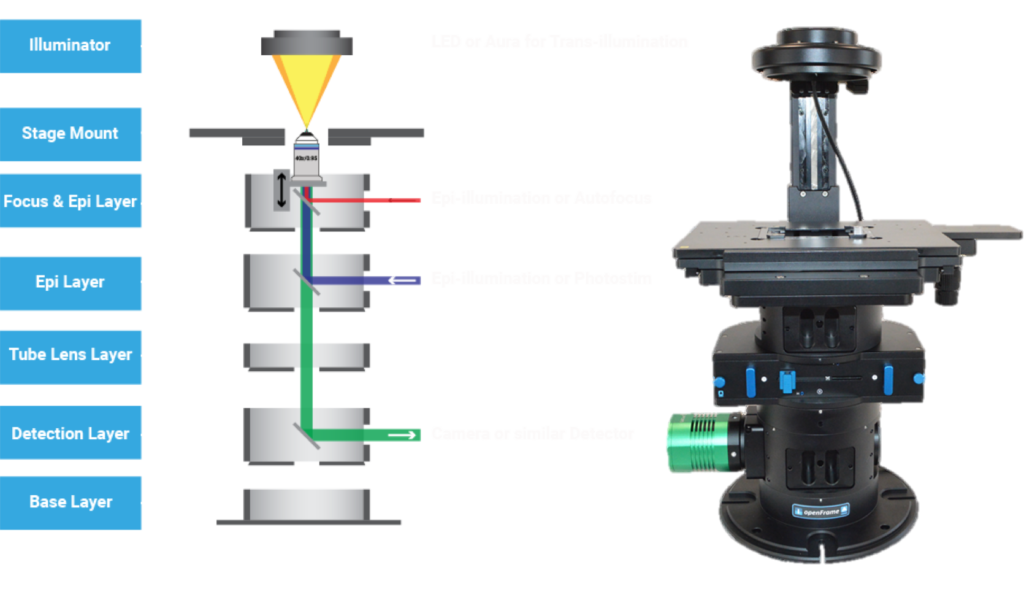Module Layers
As shown in the system overview diagram below, each openFrame microscope is a simple stack of functional Layers. This can range from just three layers for a basic widefield microscope, up to five (or more) for systems configured for advanced multimodal or multichannel microscopy.

In the more advanced configurations, each layer can have up to two fully independent detection or illumination ports. This is achieved using our unique 25 & 32mm beamsplitter cube designs which can be interchangeably mounted to create both left and right ports on the same layer. This enables a single instrument to have twice the number of detection and illumination channels of current industry standard microscopes – allowing for more compact and more affordable systems – without compromising performance.
Focus Layer
The Focus Layer adds either manual or motorised focusing capabilities to the openFrame microscope.
The openFrame platform allows for several different focusing options. For low-cost and simple systems, the sample can be moved using a 3D manual microstage. More commonly, the sample remains fixed and the objective is translated along the optical axis. On the openFrame this can be achieved with a manual micrometer, but in the majority of cases we advocate simple or encoded motorised focus drives. In this instance, options for one or two objectives are also available.
Epi-Illumination Layer
The Epi-Illumination Layer is used to couple a wide variety of illumination sources into the openFrame’s infinity space. Several options are available to suit your needs: The Standard Layer and the Universal Layer.
Immediately under the Focus Layer is the first layer that allows illumination sources to be coupled into the openFrame microscope. This can range from basic single wavelength LED illumination to substantially more advanced illumination systems such as laser scanners used for TIRF, FRAP or photomanipulation experiments. A key defining feature of all the options is that any filter cubes or mirror mounts being used can be individually tip-tilt adjusted. This allows for straightforward optical registration of all illumination channels, to ensure zero pixel shift between different illumination paths, which are especially important for demanding applications such as TIRF.
Light sources can be coupled directly in free space or remotely via a liquid light guide or multimode / single mode fibre. The illumination can be masked using Cairn’s unique dual-control adjustable rectangle aperture, to match photon exposure to the camera sensor and avoid corner bleaching when tiling images.
Tube Lens Layer
The openFrame platform is designed to work with tube lenses from Evident (formerly Olympus Lifesciences), Nikon and Thorlabs but we also have our own designs and custom options for certain specialist requirements.
The tube lens will usually be horizontally thread-mounted to the base of any layer, with a dedicated spacer layer underneath to accommodate its length. Alternatively they can be mounted vertically on detection ports to allow for larger numbers of cameras to be included in a system – in which case the system includes multiple tube lenses. If multiple tube lenses are used, these should all be of the same type if pixel registration is required, but can be different focal lengths if differential magnification or resolution is required between detectors.
The tube lens marks the end of the infinity space. Usually, only detection components are located below it.
Detection Layer
Below the illumination layer(s) and the tube lens follows the detection section of the openFrame. This can consist of one or two layers. In the case of two layers, the first would be configured as the first Detection Layer.
In most systems, the detectors will be (s)CMOS or EMCCD cameras, but they could also be Photomultipliers, APDs or spectrometers. Each detection layer can have one or two active detection ports. For dual port detection, a basic manual and a fully motorised option are both available to divert the light to the left or the right as required.
Mechanical connection of the detectors is achieved with any standard interface, such as C-, T-, F-, and M48-mounts.
Base Layer
To provide stable mounting of your system to the anti-vibration table, the last layer in every openFrame microscope is a dedicated base. This includes slots to allow flexible mounting onto both metric and imperial optical table hole patterns using either M6 or 1/4-28 bolts.
For researchers needing an extra (camera) port, the Base Layer has an SM2 threaded port at the bottom. This allows an extra optical component such as a camera to be mounted. In this case, the microscope is mounted to the table via a set of optical posts to lift it sufficiently, or alternatively, the table is pre-drilled with a hole for a bottom port.

